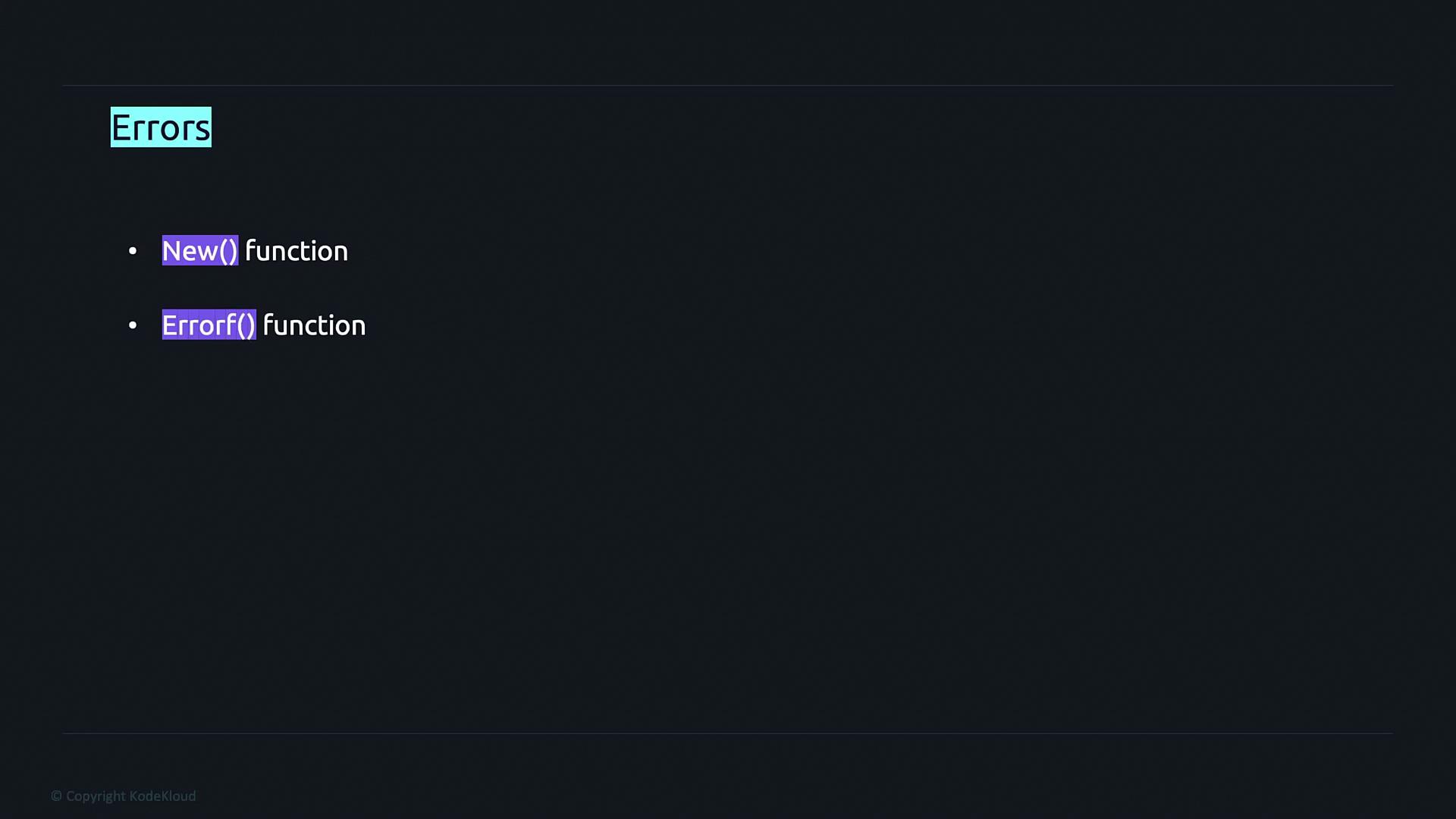Advanced Golang
Core packages
Errors
In this article, we explore error handling in Go programming, a fundamental aspect of building robust applications. Go does not rely on traditional try-catch blocks for error handling; instead, it offers its own straightforward mechanisms. Understanding these mechanisms is key to building resilient Go applications.
Built-in Error Functions: New() and Errorf()
Go provides two commonly used functions for creating and formatting errors: New() and Errorf(). These functions are part of Go's standard libraries and help streamline error handling in your code.

Using errors.New
The built-in errors package includes the New function, which returns an error formatted with the provided text. You can review the documentation by running:
Desktop/codekloud/learn via 🐹 v1.19.3
$ go doc errors New
package errors // import "errors"
func New(text string) error
New returns an error that formats as the given text. Each call to New
returns a distinct error value even if the text is identical.
Every invocation of errors.New generates a unique error object—even if the error message string is the same. Below is an example of using New to create and display a custom error message:
package main
import (
"errors"
"fmt"
)
func main() {
err := errors.New("Custom error occurred")
fmt.Println(err)
}
When you run the program, it prints the custom error message to the console.
Note
Go's error handling is based on explicit checking. Always check whether an error variable is nil before proceeding.
Error Handling with if-else Conditions
Rather than relying on exceptions, error handling in Go typically involves testing if an error variable is nil. Consider the following example, where a function processes an integer and returns an error if the number is even (permitting only odd numbers):
package main
import (
"errors"
"fmt"
)
func process(i int) error {
if i%2 == 0 {
return errors.New("Only odd numbers allowed")
}
return nil
}
func checkError(e error) {
if e != nil {
fmt.Println(e)
} else {
fmt.Println("Operation successful")
}
}
func main() {
err := process(3)
checkError(err)
err = process(2)
checkError(err)
}
When executed, this program produces the following output:
Desktop/kodekloud/learn via 🐹 v1.19.3
$ go run main.go
Operation successful
Only odd numbers allowed
In this example, passing an odd number results in a successful operation, while an even number triggers an error message.
Enhancing Error Messages with fmt.Errorf
For more detailed error messages, you can use the fmt.Errorf function from the fmt package. This function lets you create formatted error messages by incorporating dynamic information. Here is the documentation snippet for fmt.Errorf:
Desktop/kodecloud/learn via 🐱 v1.19.3
$ go doc fmt Errorf
package fmt // import "fmt"
func Errorf(format string, a ...any) error
Errorf formats according to a format specifier and returns the string as a value that satisfies error.
The following example demonstrates how to update the process function to dynamically include the provided integer in the error message:
package main
import (
"fmt"
)
func process(i int) error {
if i%2 == 0 {
return fmt.Errorf("only odd numbers allowed, got: %d", i)
}
return nil
}
func checkError(e error) {
if e != nil {
fmt.Println(e)
} else {
fmt.Println("Operation successful")
}
}
func main() {
err := process(3)
checkError(err)
err = process(2)
checkError(err)
}
Executing this program produces output similar to:
$ go run main.go
Operation successful
only odd numbers allowed, got: 2
This demonstrates how to create custom error messages and effectively manage errors using both errors.New and fmt.Errorf.
SEO Tip
In your Go projects, ensure to check errors immediately after function calls to enhance code reliability and maintainability.
Watch Video
Watch video content